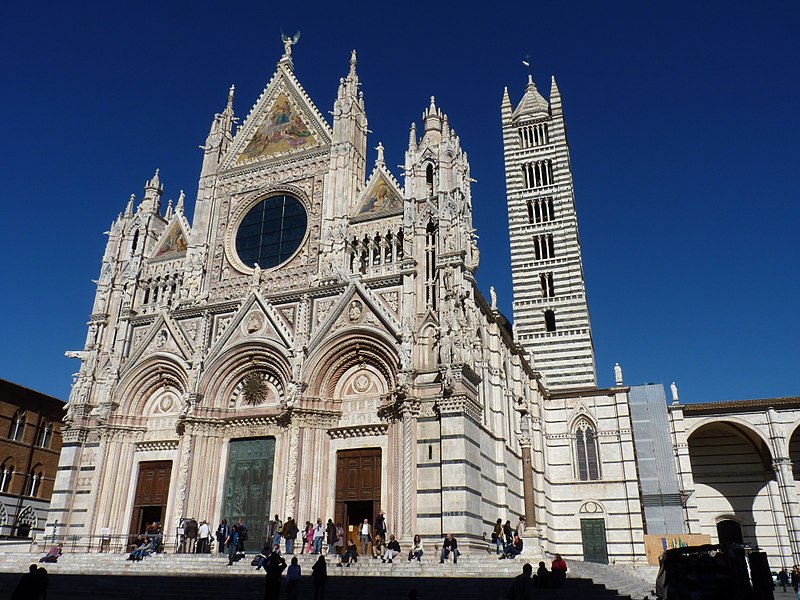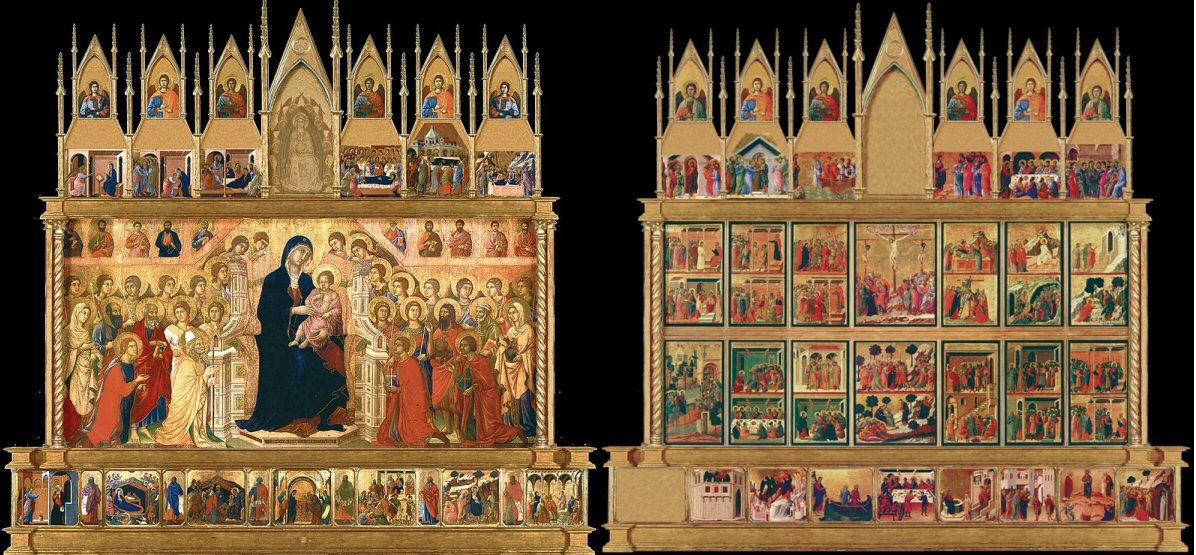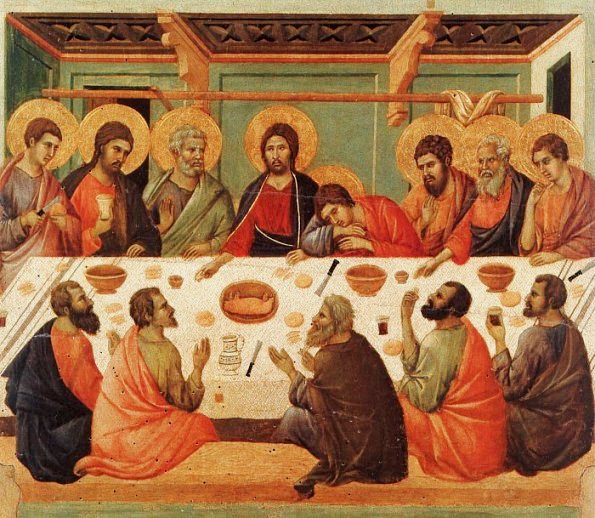The Last Supper did not originate with Leonardo da Vinci. It wasn’t even his idea. Somebody first painted it about 20 years after the crucifixion of Jesus, and it’s entirely possible that the artist could have been in the crowd that welcomed him into Jerusalem.
According to the New Testament, Jesus entered Jerusalem for the Feast of Passover and sent Peter and John ahead to meet a man who would show them to their accommodation. When they had rested from the journey, they all came together to eat. Jesus knew that he was in great danger, and it is very likely that he told his friends about his fears. During the meal that night, Jesus announced that he would be betrayed by one of his disciples. This caused consternation and howls of anguish from all of his friends. Jesus broke bread and gave it to his disciples, explaining that this was his body. He offered them wine, saying that this was his blood, and he charged them to spread his teachings after he was dead. This meal is the basis for the Eucarist, but is much better known as the Last Supper.
His betrayal, arrest, trial and subsequent crucifixion separated him from the Jewish faith, which stretched all the way back to Abraham. From now on, he would be the long awaited Messiah, the son of God. In the New Testament, Paul’s First Epistle to the Corinthians (11:23–25) has the earliest reference to the meal and dates from the middle of the first century, 20 years after the crucifixion. Matthew (26:17–29) gives a detailed description of the betrayal, but was written 30 years later. Mark’s (14:12–25) was 40 years later and Luke (22:7–38) 50 years later. Some of these accounts of the life and death of Jesus are hotly debated regarding origin and authenticity, but it is possible that what happened during the meal may have been elaborated upon when verbally passed on and spread amongst the early Christians shortly after Jesus’ death.
The first paintings of the last supper date from about the same time as Paul’s First Epistle, and they were found in the catacombs in Rome. The Fractio Panis fresco in the Catacomb of Priscilla on the Via Salaria is one of the most famous of catacomb paintings and it gives an idea of how early Christians took Communion. It is one of several from the first century CE and is the clearest example we have in catacomb art of the ritual of the Eucharist during the first two hundred years of the Gentile Church in Rome. In the New Testament book of Acts, (c. 63-70) there are references to Christians gathering to “break bread,” at what was called an “Agape Love Feast.” Considering that these figures are painted above an opening in the wall where a corpse was to be placed before bricking up the tomb, the paintings are more likely to show the poor soul attending a meal in heaven with Christ rather than a worldly event. Nevertheless, this was the first painting showing the concept of a Last Supper.

In the painting, seven people, one of whom is a woman, are reclining at a table where there is a cup of red wine and two large plates. One plate contains five loaves of bread, the other two fish, replicating the numbers in the multiplication miracle from the Gospels. A man at the left end of the table is breaking a small loaf in his hands. These pictures in the catacombs are the only illustrations of how early Christians of the first century after Christ’s death devoted themselves to the new religion, with baptisms and “breaking bread” in their homes, “with glad and sincere hearts.” (Acts 2:42 to 2:46) The catacomb paintings of Rome are the first depictions of a Last Supper, but we have to wait around 1,150 years before there is another painting of the Last Supper.
In 1196, the cathedral masons’ guild, the Opera di Santa Maria, was given the commission of the construction of a new cathedral in the city of Siena, which is about 50 km south of Florence. From the outset, this was designed to be a showpiece of art and sculpture that had no rivals. The architect /sculptor who directed the masons was Giovanni Pisano, whose work on the Duomo’s (The name of the Cathedral) façade and the pulpit was influenced by his father Nicola Pisano. His famous father had sculpted the pulpit in the Cathedral in Pisa, and it was he who was commissioned to sculpt the pulpit at Siena from Carera marble. Father and son worked together to build the west façade, which uses dark and white marble in horizontal stripes. This is the most impressive of the four façades of the Cathedral, with the middle of the three entrance portals overlooked by a huge bronze sun.
 The Dumo Catherdral, Siena
The Dumo Catherdral, Siena
Work was started on the north–south transept, and by 1215 the priests were already holding daily masses in the new church. The pulpit was finished and added in 1268, and is the oldest original work of art in the Cathedral. However, by this time Nicola had died sometime before 1284, and though Giovanni had taken up residence in Siena, he left abruptly in 1296 after falling out with the Opera di Santa Maria. He returned to Pisa, (His and his father’s home town.) and began working on their Cathedral.
I imagine that you are wondering what all this has to do with the Last Supper, well here is the link.

The altarpiece showing front on the left and the rear on the right.
In 1308, the Bishop of Siena commissioned the artist Duccio di Buoninsegna, a local artist, to paint an altarpiece for the cathedral. The front of the altarpiece showed the Madonna and Child with saints and angels. The reverse had panels showing the life of Christ and the life of the Virgin in 43 small scenes. The wooden altarpiece was mounted on a plinth, or praedella, on which were painted panels showing the childhood of Christ. The idea was that it could be seen from all directions when installed on the main altar at the centre of the sanctuary. At five meters high, it was a pretty impressive altarpiece for the time, and turned out to be the artist’s biggest commission and greatest work.
The construction of the altarpiece itself before painting was a complicated job involving the cutting, jointing and gluing of many frames and panels. The central panel alone was 2.1meters by 4 meters. When the carpenters had finished, it was left to Buoninsegna and his assistants to paint the scenes on the panels in his studio close to the cathedral.
On 9 June 1312, the altarpiece was unveiled and carried around the streets of Siena in a great circle before being installed in the cathedral. All the shops and workshops in the city were closed and the bishop commanded that all the high officers and devoted priests, followed by the population of Siena were to file past carrying candles. The cathedral bells rang and the poor received alms and the whole city prayed to the Holy Mother of God that she might “in her infinite mercy preserve this, our city, from every misfortune, traitor or enemy.”
One of the panels showing the life of Christ is this scene showing the last supper. Buoninsegna was occupied with the Maestà of Duccio as it became known, for at least two years and he was probably unaware that he was changing the style of art in the process. Until now, religious art had been very formalised and stylistic. Duccio, either deliberately or in haste, painted his scenes much more realistically. Church congregations in those days were mostly illiterate, and his depiction of the bible in everyday terms was very popular. Duccio became one of the most favoured and radical painters in Siena and his fame spread. Unlike many of the artists of the time, he painted in egg tempera and became a master in the medium.

Unfortunately, the local boy struggled with his own reality. There is little documentation concerning his life except for lists of unpaid bills. He is said to have been married with seven children, and when he died in 1260 his family disowned him because of his debts. His masterpiece fared a little better. The altarpiece remained in position for 465 years until it was decided to display it in pieces arranged between two alters. During the dismantling, many of the paintings were damaged and several disappeared or were sold. Some of the panels can now be found in in other museums in Europe and the United States. The panels that remain in Siena can be seen in the Duomo museum adjacent to the Duomo di Siena.
As we all know, this is not the end of the story for the idea of a last supper, or the artists who developed its potential.